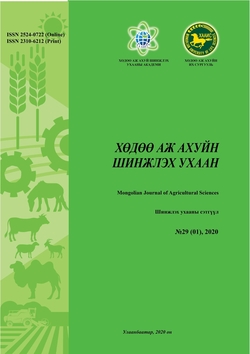Experimental result on improvement of traditional technology for processing sheepskin
DOI:
https://doi.org/10.5564/mjas.v29i1.1389Keywords:
sheepskin, whey, aluminum potassium sulfate, shrinkage temperatureAbstract
This study was conducted to improve the quality of sheepskin, which was treated withmongolian traditional methods using whey. We pickled Mongolian sheepskins using whey, and tanning was processed by aluminum potassium sulfate. The temperature of shrinkage of the sheepskin in our experiment was 73 ° C, which corresponds to the requirement of the standard MNS 0528: 2016 for processed sheepskin where it is indicated that the temperature of shrinkage should be above 70°C. According to the requirement of the standard, the moisture content of the processed sheepskin should not be lower than 14%, then in the experimental version 8.5%, also the pH should be in the range of pH 4.0-4.5 then in the experimental version 4.2.
Уламжлалт аргаар боловсруулсан нэхийний чанарыг сайжруулах туршилтын дүн
Энэхүү судалгааг монголын уламжлалт арьс боловсруулах сүүн идээлгийн чанарыг сайжруулах зорилгоор хийлээ. Бид монгол хонины арьсыг шар сүүний ганд гандаж, нэмэлт идээлгийг хөнгөн цагааны цөрөөр явуулан арьсны чаналтын температурыг 73°С хэмд хүргэв. Боловсруулсан нэхийнд тавигдах MNS0528:2016 стандартын шаардлагад арьсны татах цэг 70°С хэмээс дээш байх гэсэн шаардлагыг хангаж байна. Нэхийний чанарын бусад үзүүлэлт тухайлбал, чийг 14-өөс доошгүй байх шаардлагатай байхад биднийх 8.5%, арьсны рН 4.0-4.5 хооронд байхаас 4.2 байгаа нь стандартад нийцэж байгааг харуулж байна.
Түлхүүр үг: нэхий, шар сүү, цагаа, хөнгөн цагааны цөр, чаналтын температур
Downloads
1238
Downloads
Published
How to Cite
Issue
Section
License
Copyright on any research article in the Mongolian Journal of Agricultural Sciences is retained by the author(s).
The authors grant the Mongolian Journal of Agricultural Sciences a license to publish the article and identify itself as the original publisher.

Articles in the Mongolian Journal of Agricultural Sciences are Open Access articles published under a Creative Commons Attribution 4.0 International License CC BY.
This license permits use, distribution and reproduction in any medium, provided the original work is properly cited.




